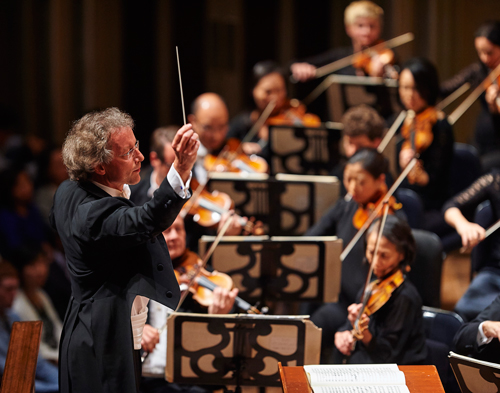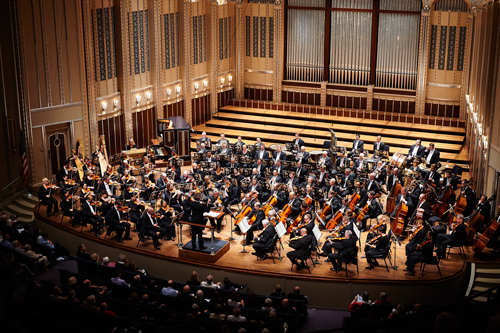by Daniel Hathaway

Thursday, October 8 was designated “Brown” and included Oliver Messiaen’s L’Ascension and Couleurs de la cité celeste, ending with Richard Strauss’s Also sprach Zarathrustra. Friday, October 9 was “Yellow” and began with Oliver Messiaen’s Chronochromie. Messiaen’s Couleurs followed intermission, and the evening ended with the Stabat Mater and Te Deum from Giuseppi Verdi’s Four Sacred Pieces, featuring the Cleveland Orchestra Chorus. Saturday, October 10 was “Red,” beginning with Zarathrustra and continuing with Couleurs and Verdi. I heard all of the works in the course of the Thursday and Friday performances.
Beyond whatever metaphysical connections could be drawn between these six works, the Orchestra is playing all of them on its European tour between October 15 and 31 (plus other works that have already appeared on its fall programs in Cleveland). As a famous choral guru once observed, one performance can be worth six rehearsals, and Severance Hall Audiences have already enjoyed a virtual trip to Brussels, Luxembourg, Milan, Paris, Cologne, Dortmund, Regensburg, and Vienna without boarding a plane.
Earlier, Franz Welser-Möst and the Orchestra opened the Blossom season on July 11 with a concert that included Messiaen’s L’Ascension, 4 méditations symphoniques. Written in the early 1930s and predating the composer’s later obsession with birdsong and Hindu rhythms, the suite takes its inspiration from Roman Catholic mysticism, considering the ascension of Christ through quotations from the Gospel of John, the Mass texts for the Feast of the Ascension, and Psalm 47.
The train whistles and sounds of nature were missing from Thursday’s performance in Severance Hall, but the indoor version of L’Ascension enjoyed a full palette of purely musical hues. The brass managed the tricky opening first movement (for winds and brass alone) with only a few minor burbles, Robert Walter’s handsome English horn solo in “Alléluias sereins” was enrobed by a wonderful haze of strings, and “Alléluia sur la trompette…sur la cymbale” was triumphant, with clanging chords leading to a deafening “bam!” at the end. Finally, Christ rose to heaven on a cloud of timeless string harmonies.
After a major stage reset and a bit of a kerfuffle when trombone music went missing, twenty players reassembled for Messiaen’s Couleurs de la cité céleste, a 1963 commission from Germany’s Donaueschingen Festival. The commissioners had asked for a piece for three trombones and three xylophones, but ended up with a more extensive band that added solo piano, three clarinets, two horns, four trumpets, a fourth trombone, and extra percussion to the original ensemble.
The composer’s inspiration once again came from Catholic mysticism, and specifically the Book of Revelation, but by this point Messiaen’s interests in rhythmic theory, birdsong and the musical representation of color had become fully developed.
Messiaen’s 15-minute vision of the Holy City is as hard-edged as the precious stones that garnish the city’s walls. Percussive sounds from the xylophone, xylorimba, marimba, cencerros (cowbells), jeu de cloches (tubular bells), gongs and the upper reaches of the solo piano contrast with the apocalyptic tones of the trombones, the seven solo brass instruments that represent the seven angels, and the odd trio of clarinets, who are isolated downstage left.
Joela Jones handled her demanding piano part with predictable mastery, making stylish, expressive releases after each of her striking solo passages. The ensemble, which sounded confident and relaxed on Thursday, only increased in its precision on Friday.
Messiaen’s Chronochromie began Friday’s concert. Written a few years before Coleurs and for the same German festival, the 30-minute work, which received its American premiere by The Cleveland Orchestra under Georges Prêtre in 1967, is scored for large orchestra with a big percussion complement. Based on the ground plan of an ancient Greek ode, the work explores the interaction of time and color, while introducing the authentic songs of numerous birds from four countries who probably have never had the opportunity to sing together outside this piece.
Mesmerizing in its texture and kaleidoscopic colors, Chronochromie is also a vehicle for some astonishing mallet playing, starring in this case Marc Damoulakis and Tom Freer, who matched their impressive performance from last May on Friday. The eighteen solo string players who represented individual birds in the final section created a splendid avian din.
Thursday evening culminated in a full stage of musicians and Richard Strauss’s tone poem Also sprach Zarathrustra. Franz Welser-Möst looked beyond its portentous opening gestures to the music that lay ahead, untangling Friedrich Nietzsche’s tortuous journey toward self-realization to reveal the inner gorgeousness of Strauss’s musical landscape. The elegant waltz toward the end provided a burst of orchestral virtuosity (crowned by William Preucil’s violin solo) that lingered in the ear even through Das Nachtwandlerlied (the second appearance this fall of Nietzsche’s poem that brought Mahler’s third symphony to such a glorious halt last week).
But that wasn’t the last note the audience heard on Friday. Stravinsky’s Fireworks (his Opus 4) provided a dazzling, unannounced postscript to the evening.
After Chronochromie and Couleurs, Friday’s closer featured the Cleveland Orchestra Chorus in a mellifluous performance of two of Verdi’s Four Sacred Pieces. “Stabat Mater” is a compact and affecting setting of a 13th-century devotional poem that traces the sufferings of Jesus through the emotional response of his mother. Though his setting is dramatic — and chromatic — Verdi resists over-sentimentalizing the text. The chorus, superbly prepared by Robert Porco, responded like chameleons to every emotional change in Verdi’s music.
In the “Te Deum”, the men admirably kept their pitch through the unaccompanied introduction before the orchestra and the rest of the chorus entered with the stunning chords of “Sanctus, Sanctus, Sanctus.” Powerful climaxes and muted expressions of piety ensued as the chorus skillfully alternated between unison passages and eight-voice textures. Finally, a solo voice from the chorus wrapped up this early Christian hymn on a somber, reflective note.
It might have been a stretch to include two Messiaen and two Verdi works on the same program, but that plan succeeded admirably on Friday evening.
Photos by Roger Mastroianni.
Published on ClevelandClassical.com October 13, 2015.
Click here for a printable copy of this article




